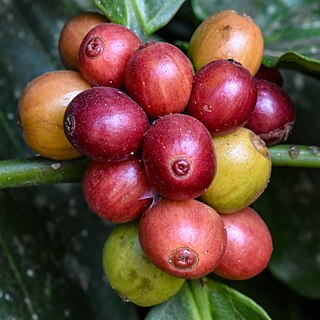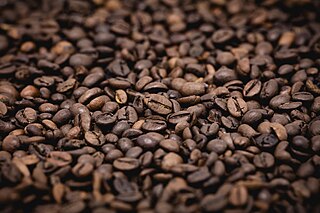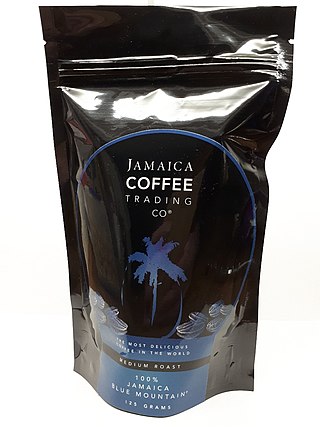
Coffee is a beverage brewed from roasted, ground coffee beans. Darkly colored, bitter, and slightly acidic, coffee has a stimulating effect on humans, primarily due to its caffeine content. It has the highest sales in the world market for hot drinks.

Coffea canephora is a species of coffee plant that has its origins in central and western sub-Saharan Africa. It is a species of flowering plant in the family Rubiaceae. Though widely known as Coffea robusta, the plant is scientifically identified as Coffea canephora, which has two main varieties, robusta and nganda.

Coffee is a popular beverage and an important commodity. Tens of millions of small producers in developing countries make their living growing coffee. Over 2.25 billion cups of coffee are consumed in the world daily. Over 90 percent of coffee production takes place in developing countries — mainly South America — while consumption happens primarily in industrialized economies. There are 25 million small producers who rely on coffee for a living worldwide. In Brazil, where almost a third of the world's coffee is produced, over five million people are employed in the cultivation and harvesting of over three billion coffee plants; it is a more labor-intensive culture than alternative cultures of the same regions, such as sugar cane or cattle, as its cultivation is not automated, requiring frequent human attention.

Indonesia was the fourth-largest producer of coffee in the world in 2014. Coffee cultivation in Indonesia began in the late 1600s and early 1700s, in the early Dutch colonial period, and has played an important part in the growth of the country. Indonesia is geographically and climatologically well-suited for coffee plantations, near the equator and with numerous interior mountainous regions on its main islands, creating well-suited microclimates for the growth and production of coffee.

Coffee production in India is dominated in the hill tracts of South Indian states, with Karnataka accounting for 71%, followed by Kerala with 21% and Tamil Nadu. Indian coffee is said to be the finest coffee grown in the shade rather than direct sunlight anywhere in the world. There are about 250,000 coffee growers in the country; 98% of them are small growers. As of 2009, Indian coffee made up just 4.5% of the global production, being the 7th largest producer of coffee. Almost 80% of Indian coffee is exported; 70% is bound for Germany, Russia, Spain, Belgium, Libya, Poland, Jordan, Malaysia, U.S.A, Slovenia and Austria. Italy accounts for 20.37% of the exports. Most of the export is shipped through the Suez Canal.

Coffee is an important agricultural product in the Philippines, and is one of the Philippines' most important export products aside from being in high demand in the country's local consumer market.

Laos produces two main types of coffee: Robusta and Arabica. Robusta is mainly used for regular coffee as well as a typical coffee drink in Laos where it is sweetened with condensed milk. The latter, Arabica, is of a higher quality due to its mild taste, and it is used for espresso. For the 20,000 tons of coffee that Laos produces a year, 5,000 tons are Arabica beans and 15,000 tons are Robusta.

Coffee production in Tanzania is a significant aspect of its economy as it is Tanzania's largest export crop. Tanzanian coffee production averages between 30,000 and 40,000 metric tons annually of which approximately 70% is Arabica and 30% is Robusta.

Coffee is Uganda's top-earning export crop. In 1989 Uganda's coffee production capacity exceeded its quota of 2.3 million bags, but export volumes were still diminished by economic and security problems, and large amounts of coffee beans were still being smuggled out of Uganda for sale in neighbouring countries. Uganda is one of the few countries in the world with indigenous coffee, with Robusta coffee growing wild around Lake Victoria.

Coffee has been grown in Cuba since the mid-18th century. Boosted by French farmers fleeing the revolution in Haiti, coffee farms expanded from the western plains to the nearby mountain ranges. Coffee production in eastern Cuba significantly increased during the 19th and early 20th centuries. At its peak production, Cuba exported more than 20,000 metric tons of coffee beans per year in the mid-1950s. After the Cuban Revolution and the nationalization of the coffee industry, coffee production slowly began to decline until it reached all time lows during the Great Recession. Once a major Cuban export, it now makes up an insignificant portion of Cuban trade. By the 21st century, 92 percent of the country's coffee was grown in area of the Sierra Maestra mountains. All Cuban coffee is exported by Cubaexport, which pays regulated prices to coffee growers and processors.

Coffee production in Democratic Republic of the Congo (DRC) is centered in the Lake Kivu provinces. There are about 11,000 coffee farmers in the country who produce two main species of coffee, Robusta and Arabica.
The production of coffee in Paraguay began in the late 19th century. Plantations were known at that time near Asunción and Limpio.
Coffee production in Panama was occurring in the Boquete Valley by the early 20th century, although coffee was growing wild all over the Pacific coast region of Panama by this time, when production did not match domestic consumption. The International Coffee Organization (ICO) has grouped mild arabica as the variety of coffee that is grown in Panama. The best quality of coffee in Panama is grown in Boquete. In the Coffee Review of 2008, two Panamanian coffees have received higher rating and fetched record prices than the coffee from Costa Rica. This is mainly due to the unprecedented success of the Geisha varietal. This varietal originated from and arrived via Tanzania and Costa Rica in the 1960s in Panama. But only in 2004, its outstanding taste profile was recognized. In 2019 one pound of Panama Geisha beans fetched $1,029 in an auction.
Coffee production in the Dominican Republic is based mainly in the mountain regions of the country, in the highlands which form at least one-half of the area of Hispaniola. Introduced to the country in 1715, the Dominican Republic bean is larger and thicker than Martinique's. The major coffee variety grown in the country is Arabica. Robusta is also grown but only in about 1.3% of the land area; it is consumed locally.

Coffee production in Jamaica began after 1728, when governor Sir Nicholas Lawes introduced the crop near Castleton, north of Kingston. Jamaican Blue Mountain Coffee is the special variety of coffee that is grown in the Blue Mountains region, which has the most conducive climate and topographical features; this variety is known for its scent and sweet taste. Most of Jamaica's coffee production is grown for export.

Coffee production is very important for the economy of Cameroon The crop is grown extensively in the country, with robusta more prevalent in the coastal areas and arabica more widespread in the western highlands. The two varieties of arabica cultivated are Java and Jamaïca of which only Java is resistant to pests such as coffee berry disease and rust. In 2014, Cameroon was ranked the 31st largest producer of coffee in world.

Peru is one of the top 20 coffee producers in the world as of 2014. It ranks fifth in the export of Arabica in the world market.
Modern cultivation of coffee in China began in 1988. In 2016 and 2017, China was among the top 20 worldwide producers of coffee. Ninety-eight per cent of the coffee grown in China comes from Yunnan province.
Benguet coffee, also known as Benguet arabica, is a single-origin coffee varietal grown in the Cordillera highlands of the northern Philippines since the 19th century. It belongs to the species Coffea arabica, of the Typica variety. It is one of the main crops of farmers in the province of Benguet, which has a climate highly suitable for arabica cultivation. Benguet coffee is listed in the Ark of Taste international catalogue of endangered heritage foods by the Slow Food movement.















